Grenfell Tower cladding failed to meet standard
Fire tests carried out as early as 2014 showed cladding used on Grenfell Tower failed to meet the safety standards originally claimed by its manufacturer, a BBC investigation has found.
The firm Arconic knew the test rating had been downgraded, but the UK body that certifies building products said it was not told about the change.
An industry source, who has worked on a number of cladding schemes, said he believed there should have been a product recall.
Arconic said it did share the rating with "various customers and certification authorities".
It said the results were also published on the website of the French facility that carried out the tests in 2014 and 2015.
The cladding used on Grenfell was Reynobond PE, aluminium panels containing a plastic filling, that were popular in cost-conscious council refurbishment schemes.
While zinc cladding was initially considered when the tower was refurbished in 2015, Reynobond PE was a cheaper option, saving nearly £300,000.
In the standard European tests for "reaction to fire", products are rated A to F - with A being the top rating. Reynobond PE had a certificate based on a rating of B.
Some in the construction industry regarded this to be the required standard for use on buildings over 18m in height, though the government says this was wrong and it should have been A rated.
The rating was issued in 2008 by the British Board of Agrément (BBA), which used technical data provided by the manufacturer to assess the standard of the panels.
However, the BBC has uncovered a series of reports commissioned by the manufacturer in 2014 and 2015, during the planning for the Grenfell refurbishment.
Two configurations of the cladding, both later to be fitted at Grenfell, were tested.
One, known as "riveted", was given a classification of C, not B as was stated on the certificate.
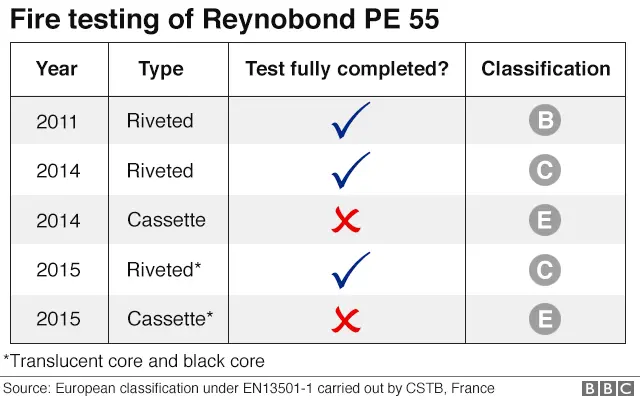
Another type, the "cassette system", where the panels are formed into shapes before being fitted, was classified as E. In this case, the reports suggest the testing process was not completed.
However, the BBC also obtained Arconic correspondence sent to clients from late 2015 in which the company appears to confirm some of the panels were rated class E.
The email specifically addresses "concerns about the product's fire reaction class in the UK".
The BBC spoke to one source, who has worked on major cladding schemes, though not Grenfell.
He told us the email was not sent to his company's technical department and was only found after an intensive search of all company records following the Grenfell fire.
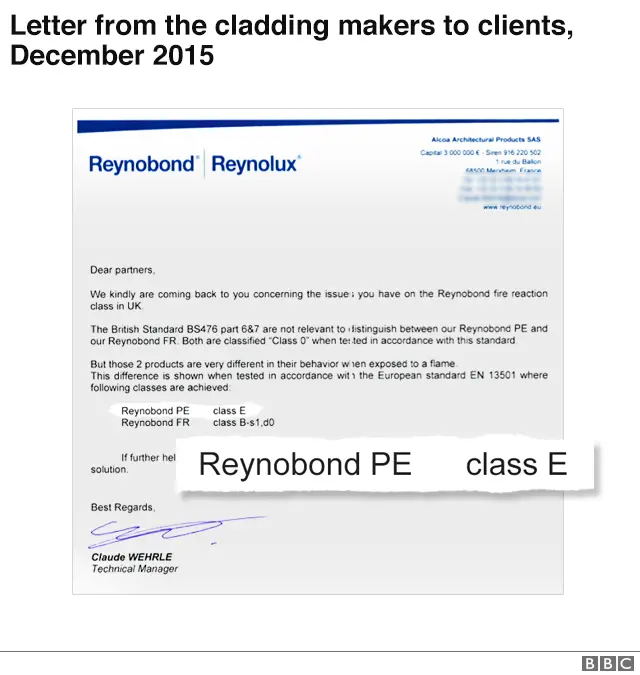
The source said E rated cladding would have been unacceptable in the projects he worked on.
"To be blunt," he said, "you wouldn't put E on a dog kennel".
He said he should have been informed of the classification results by Arconic with a product recall.
"We would have had to inform our client who would have had a duty of care to say this material is no longer compliant with building control or building regs and should be removed from buildings."
That will now happen, but only as a result of the Grenfell fire and the loss of 71 lives.
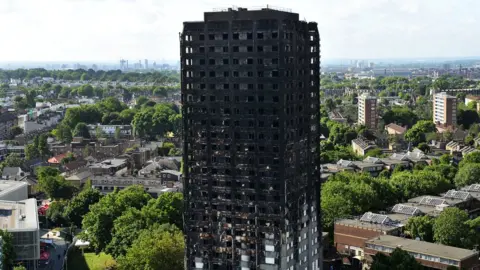 AFP
AFPFire testing is carried out regularly by companies producing building materials and, because the results are commercially sensitive, they are not made public.
Instead, manufacturers share their results with The British Board of Agrément (BBA).
After seeing the BBC's evidence the BBA said it "was not notified that there were other test results available in addition to those quoted in the BBA Certificate.
"It is a requirement of the certification process that the BBA is informed of information like this."
The inspectors who "sign off" construction projects rely on the accuracy of the BBA certificates.
Barry Turner, the technical director of Local Authority Building Control, which represents all council building control teams, said: "We are very dependent on the manufacturer telling us there has been a change to that product.
"If someone comes with a classification which doesn't meet what's indicated in the building control guidance then we would say 'that's not suitable. Go away and find another product.'"
What are the regulations in the UK?
Since the Grenfell Tower fire, ministers and experts have argued that buildings over 18m needed to meet a class A standard, not B.
But many in the construction industry claim the guidance for meeting the building regulations was unclear until after the fire.
In England and Wales, class B is still regarded as the required standard for some buildings of less than 18m in height which are close to other structures.
The BBC's latest findings could also result in scrutiny of buildings in Scotland where a B classification can also be used on tall buildings under certain circumstances.
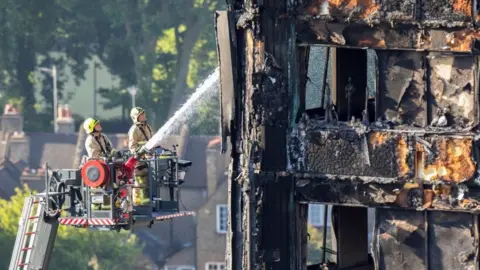 PA
PAHow has Arconic responded?
Arconic told us: "We previously provided the classification results to various customers and certification authorities, and they were also posted on the CSTB's publicly available website."
The CSTB is the French facility which carried out the tests.
If the reports were available on its website, they are not now, and the CSTB was not able to provide them. The BBC obtained them through other sources.
We could find no mention in Arconic's marketing material of the lower classifications for the cheaper Reynobond PE cladding.
However, the company advertises more expensive versions of its cladding that were classified A2 and B in the European tests.
Arconic also suggested the BBA certificate could not be relied on alone as a mark of fire safety.
Its statement said: "The relevant UK building codes and regulations require entities who design the cladding system, such as architects, fabricators, contractors, or building owners, to conduct their own full systems testing or analysis of the entire cladding system."
What more do we know about the Grenfell cladding?
The BBC can also reveal Grenfell Tower was fitted with two different versions of the Reynobond PE cladding.
Arconic changed the makeup of its product, replacing the grey translucent plastic with a black material, also plastic, during the refurbishment of the tower.
It said the change was made to ensure cladding would weather better in direct sunlight and the test results suggest the new version performed better when exposed to flames.
Yet some of the older cladding was already installed on Grenfell and other towers, and was not removed.
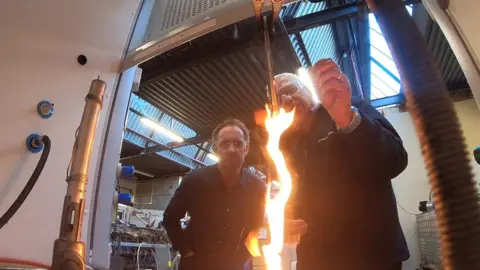
What did our testing of the panels show?
We asked plastics experts at Impact Solutions near Edinburgh to analyse the older and newer versions of the panel for the BBC.
They concluded both were made of polyethylene plastic.
However, chemical analysis suggested the original Reynobond panel had a wax ingredient, possibly added to make it easier and cheaper to form into sheets.
The Impact Solutions experts believe this substance was removed for the newer version of the cladding.
At our request, the company exposed the panels to a flame under laboratory conditions, demonstrating that the newer version burned for a slightly shorter period than the older.
But both samples caught fire within two minutes, both dropped streams of melted, flaming plastic.
Les Rose, from Impact Solutions, described the speed at which the plastic burnt as "fairly dramatic", observing that it appeared to be "feeding the flames".
He regarded neither type of cladding as adequate for fixing to tall buildings.
Since the Grenfell disaster, Arconic has withdrawn Reynobond PE from the market for all building uses.
The company is now being forced to disclose evidence to investigations by the police and the Grenfell Tower public inquiry.
